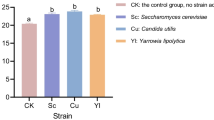Abstract
High concentrations of ochratoxin A (OTA) in feed lead to growth depression in animals. It has been reported that binders can be used for deactivating aflatoxins but not for other mycotoxins without negatively influencing the animals health. In this study a strain from the genus ofTrichosporon with the ability to cleave ochratoxin A very selectively into phenylalanine and the non-toxic ochratoxin α (OTα) could be isolated. This strain was selected from a pool of OTA detoxifying microorganism by carrying out several investigations.Trichosporon sp. nov. can be fermented and stabilized. In a feeding trial with broilers lyophilizedTrichosporon-cells could compensate performance losses caused by OTA.
Similar content being viewed by others
References
Schatzmayr G, Heidler D, Fuchs E, Loibner A P, Braun R and Binder E M (2002). Evidence of Ochratoxin A -Detoxification Activity of Rumen Fluid, Intestinal Fluid and Soil Samples as well as isolation of relevant microorganisms from these environments. Mycotoxin Research (2002), Volume 18A, Number 2: 183–187
Nitsch S, Fuchs E, Schatzmayr G and Binder E M (2003). Effects of dietary Ochratoxin A on broiler chicken. Posterpresentation at 25th Mycotoxin-Workshop, 19. – 21. May 2003, Giessen, Germany. Book of abstracts, page 70
Author information
Authors and Affiliations
Rights and permissions
About this article
Cite this article
Schatzmayr, G., Heidler, D., Fuchs, E. et al. Investigation of different yeast strains for the detoxification of ochratoxin A. Mycotox Res 19, 124–128 (2003). https://doi.org/10.1007/BF02942950
Issue Date:
DOI: https://doi.org/10.1007/BF02942950




